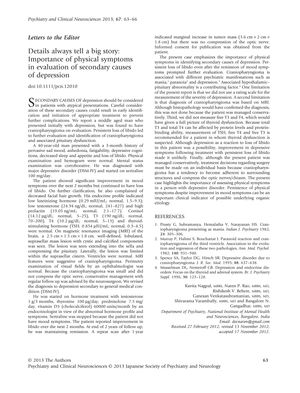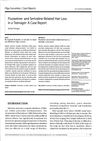Details Always Tell a Big Story: Importance of Physical Symptoms in Evaluation of Secondary Causes of Depression
January 2013
in “
Psychiatry and clinical neurosciences
”

TLDR Physical symptoms in depression can reveal underlying medical conditions.
The document reports a case of a 40-year-old man who initially presented with symptoms of major depressive disorder, including a pervasive sad mood, anhedonia, fatigability, and loss of libido, and was started on sertraline. Despite improvement in mood, his loss of libido persisted, leading to further evaluation. This revealed a craniopharyngioma, a benign brain tumor, and associated pituitary dysfunction, indicated by abnormal hormone levels. The patient's diagnosis was revised to depression secondary to a general medical condition, and he was treated with hormone replacement therapy, resulting in improvement of libido. Over a 2-year follow-up, the patient maintained remission, and a repeat scan showed a marginal increase in tumor size without optic nerve compression. The case emphasizes the importance of evaluating physical symptoms when diagnosing depression, as they can indicate an underlying organic etiology. The limitations of the report include not using a rating scale for depression severity, basing the diagnosis of craniopharyngioma solely on MRI without histopathology, and not measuring free T3 and T4 for a complete thyroid function assessment.



